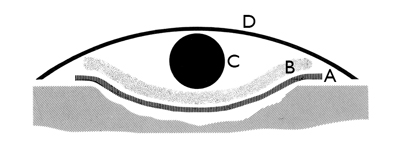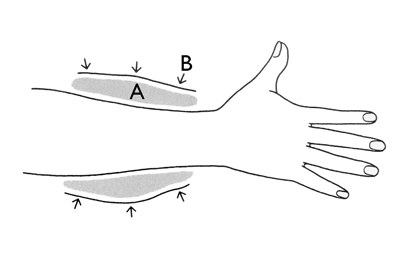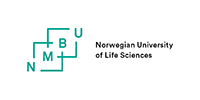A bandage is used in an attempt to improve conditions for rapid wound healing. With an external wound, the primary function of the bandage is to keep the wound dry and protect it from contamination. In the case of an internal wound, the emphasis is more on limiting swelling by exerting pressure on the body part involved, and on allowing the body part to rest by providing support.
Bandages can be divided into four groups, according to what they are used for.
Wound Dressing
This is used in the case of an (imminent) external wound to prevent contamination of the wound or the surrounding area.
The dressing comprises three layers [Figure 1]:
- Moisture-permeable layer which covers the wound (A) and which is sterile or contains an antiseptic.
- Absorbent core (B).
- Moisture impermeable and/or fixing layer (C).
The technique for applying a wound dressing is described in the section “Wound Dressings.”
 Figure 1
Figure 1
Compression Dressing
This is a variant of the wound dressing [Figure 2]. It is used for external wounds with arterial or venous bleeding. An object the size of the wound (C) is placed on top of the layer in contact with the wound (A) and the absorbent layer (B). The dressing material is fixed using a roller bandage (D) and the object (C) is pressed against the wound. By applying pressure in this way, bleeding is more likely to stop. The application is described in “The Wound Compression Bandage.”
 Figure 2
Figure 2
Compression Bandaging
This bandaging is used for internal wounds to prevent or limit swelling as the result of bleeding [Figure 3]. By tightly applying a roller bandage (B) around the body part involved, circular pressure is exerted. To ensure that the pressure is evenly distributed, a pressure-distributing layer (A) is placed between the skin and the bandage (B). The application is described in “The Compression Bandage.”
 Figure 3
Figure 3
Support and Immobilising Bandages
Wound healing is promoted by providing support and limiting or preventing movement of the body part involved.
A commonly-used support bandage for upper extremities is the sling. The forearm is supported in a triangular cloth. The Collar’n’Cuff, a stockinette with a pressure-distributing filling has a comparable function to the sling, but is more comfortable around the neck.
A plaster cast is a form of supportive bandage which more or less fully immobilises part of the body. Bandages are meant to support proprioception (or its temporary loss) and control activity by preventing any extreme movements.
Support bandages can also be used to prevent injury. One example is a preventative bandage, as well as the pressure gradient bandage used for venous insufficiency in lower extremities. Weakening of the connective and muscle tissue leads to a reduction in venous support and pump function, resulting in congestion in the vascular system of the lower legs. The use of a support bandage, in the form of an elastic stocking or bandage wraps, where the pressure decreases in the distal to proximal direction, stimulates venous return and prevents ulcer formation. A step-by-step demonstration of the techniques involved in these supportive and immobilising bandages is provided in the section “Support and Immobilising Bandages.”




























